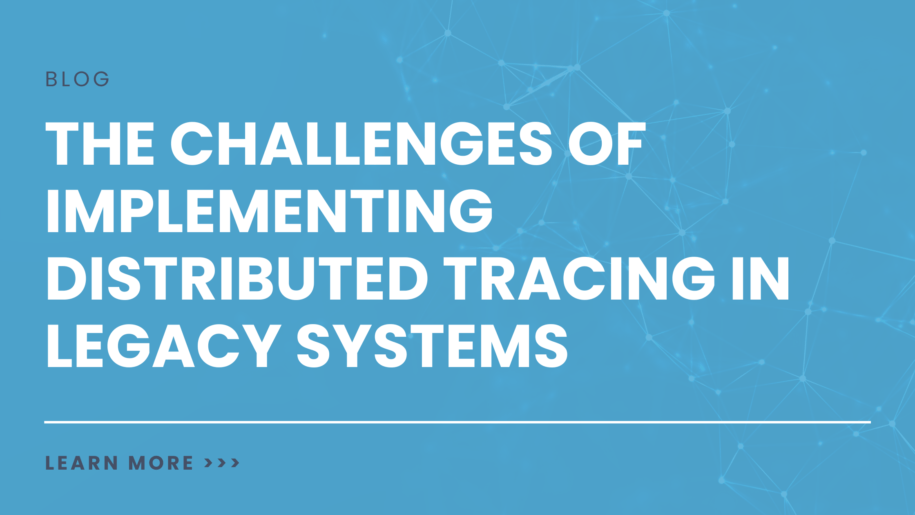Distributed tracing has become a cornerstone for monitoring and optimizing the performance of modern applications, especially in distributed and microservices-based architectures. However, implementing distributed tracing in legacy systems presents significant challenges, as these systems often lack the modularity and tools required for seamless integration. This thought piece explores the common obstacles and provides actionable strategies for organizations striving to modernize their legacy environments while implementing distributed tracing effectively.
Lack of Built-In Support for Distributed Tracing
Legacy systems were developed long before distributed tracing emerged as a critical observability tool. Consequently, they lack the native instrumentation required to collect trace data. Research from Gartner reveals that more than 70% of organizations continue to rely on legacy systems, making visibility into system behavior a complex task.
Solution: Companies can leverage open-source tools such as OpenTelemetry to introduce custom instrumentation into legacy applications to address this. While this requires effort, tools like OpenTelemetry support multiple programming languages, enabling organizations to integrate tracing capabilities into their systems incrementally.
Monolithic Architectures Impede Trace Granularity
Distributed tracing is inherently designed for systems with modular services, where each component generates trace data. However, many legacy systems rely on monolithic architectures, making it difficult to implement distributed tracing effectively. According to a report by DZone, 65% of organizations transitioning from monolithic systems encounter challenges in mapping service dependencies.
Solution: While transitioning to microservices is an option, a more practical approach for legacy systems is to modularize the application incrementally. Identifying high-impact components within the monolith and applying tracing to their critical processes can offer valuable insights without overhauling the entire architecture.
Compatibility Issues with Legacy Monitoring Tools
Legacy systems often use outdated monitoring tools that don’t support modern distributed tracing standards like OpenTelemetry, Jaeger, or Zipkin. This creates fragmented monitoring solutions, making correlating distributed trace data with other performance metrics difficult.
Research suggests that organizations using multiple monitoring tools experience a 40% increase in the time required for root cause analysis.
Solution: Modern observability platforms like FusionReactor can integrate with legacy monitoring tools and distributed tracing frameworks. Organizations can overcome compatibility issues and optimize troubleshooting workflows by creating a unified observability strategy.
Performance Overheads During Tracing Implementation
One major concern with implementing distributed tracing in legacy systems is the potential performance overhead it introduces. Legacy systems often operate under tight resource constraints and may struggle to handle the additional computational load required for trace data collection and processing.
According to a recent study, improper tracing implementation can lead to up to 20% performance degradation in legacy systems.
Solution: Organizations can use sampling techniques to minimize performance impact, such as tracing only high-priority transactions or limiting trace depth for low-priority processes. Lightweight tracing protocols and asynchronous logging can also reduce the burden on system resources.
Resistance to Change Within Legacy Teams
Cultural and organizational barriers often hinder the adoption of distributed tracing in legacy environments. Teams accustomed to traditional monitoring methods may resist new observability practices due to unfamiliarity or fear of disrupting existing workflows. A Forrester study found that 56% of enterprises cite organizational resistance as a primary obstacle to implementing modern observability solutions.
Solution: Training and collaboration are critical for overcoming resistance. Organizations can foster alignment across departments by educating teams on the benefits of distributed tracing—such as faster incident resolution and improved system performance. Demonstrating quick wins, such as reduced downtime or improved debugging times, can further encourage adoption.
The Value of Implementing Distributed Tracing in Legacy Systems
Despite the challenges, implementing distributed tracing in legacy systems is worthwhile. It provides unparalleled visibility into complex system interactions, enabling teams to optimize performance, reduce downtime, and enhance the customer experience.
Organizations must adopt a strategic approach, balancing technical solutions like incremental instrumentation and modularization with organizational changes that encourage collaboration and innovation. By addressing these challenges methodically, companies can unlock the full potential of distributed tracing—even within legacy environments.
Implementing distributed tracing may be complex, but its insights and efficiencies make it a critical step toward modernizing legacy systems and future-proofing them for an increasingly distributed world.










